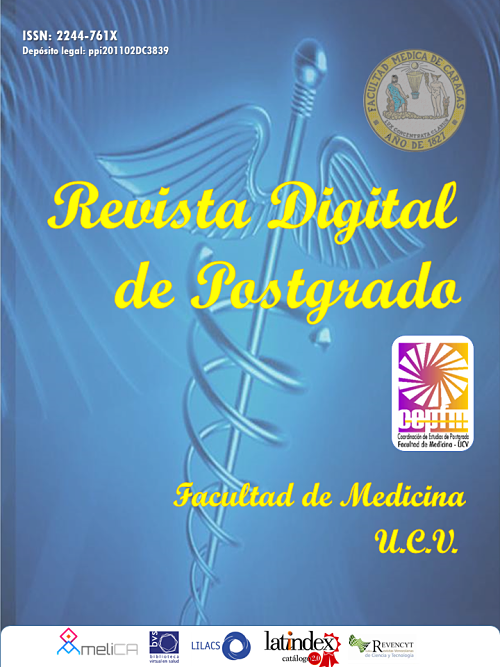Oxidation degree in patients with Type 2 Diabetes Mellitus
Keywords:
Diabetes tipo 2, Peroxidación lipídica, 4- hidroxinonenalAbstract
Introduction: Lipid peroxidation is a complex process that refers to the oxidative degradation of lipids, through which free radicals capture electrons from lipids in cell membranes, which compromises the integrity and function of the membrane. rough a series of chain reactions, lipid peroxides are formed that degrade to form reactive compounds such as malondialdehyde (MDA) and 4-hydroxynonenal, which can be quantified by different methodologies. Objective: The present work was carried out with the purpose of establishing the degree of oxidation in a population with type 2 diabetes (DM2). Methods: the sample was 55 people, made up of 30 controls between 25-35 years and 25 patients with DM2 and between 25-50 years, glycemia, triglycerides, total cholesterol, HDL-Cholesterol and LDL-Cholesterol were determined by colorimetric method. enzymatic, as well as the concentration of 4-hydroxynonenal was determined as a marker of oxidative stress. Results: e values of 4-hydroxynonenal in the control population ranged between 2.61 and 6.83 μmol/L and in diabetics 28.99 and 73.74 μmol/L., finding statistically significant differences between both populations, as well as in the lipid profile and glycemia between both groups. Conclusion: The results show an elevation of lipid peroxidation in diabetic patients, which is indicative of oxidative stress and additional risk in these patients that could lead to chronic complications of type 2 diabetes.
Downloads
References
Golbidi S, Alireza E, Laher I. Antioxidants in the Treatment of Diabetes. Current Diabetes Reviews. 2011; 7(2): 106-125. https://doi.org/10.2174/157339911794940729.
American Diabetes Association. Classification and Diagnosis of Diabetes: Standards of Medical Care in Diabetes—2018. Diabetes Care. 2018; 41(Supplement 1): S13-S27. https://doi.org/10.2337/dc18-S002.
Federación Internacional de Diabetes. Atlas de la Diabetes de la FID, 9ª edición. Bruselas, Bélgica: Federación Internacional de Diabetes, 2018. https://www.diabetesatlas.org.
Laboratory for Oxidative Stress, Rudjer Boskovic Institute, Zagreb, Croatia, 2 Institute of Biochemistry, Food Science and Nutrition, Faculty of Agriculture, Food and Environment, The Hebrew University, Rehovot 76100, Israel, and 3 Institute for Drug Research, Faculty of Medicine, The Hebrew University, Jerusalem 91120, Israel.
Calderón J, Muñoz E, Quintanar M. Estrés oxidativo y diabetes mellitus. REB. Revista de educación bioquímica. 2013; 32(2): 53-66.
Miranda M, Muriach M, Roma J, Bosh F, Genovés J, Barcia J et al. Estrés oxidativo en un modelo de retinopatía diabética experimental II: Utilidad de agentes secuestrantes de peroxinitrito. Arch Soc Esp Oftalmol. 2006; 81: 27-32
Storino M, Contreras M, Rojano J, Serrano R, Nouel A. (2014). Complicaciones de la diabetes y su asociación con el estrés oxidativo: Un viaje hacia el daño endotelial. Revista Colombiana de Cardiología. 2014; 21(6): 392-398. https://doi.org/10.1016/j.rccar.2014.09.004
Hunt J, Smith C and Wolff S. Autoxidative Glycosylation and Possible involvement of Peroxides and Free Radical in LDL Modification by Glucose. Diabetes. 1990; 39: 1420-1424.
Alvarez A, Rodríguez J, Lizano M. Diabetes mellitus tipo 2 y su influencia sobre el estrés oxidativo. Crónicas Científicas. 2020; 16(16): 40-51.
Keaney J, Vita J. Atherosclerosis, Oxidative Stress, and Antioxidant Protection in Endothelium-Derived Relaxing Factor Action. Progr. Cardiovasc. Dis. 1995; 38: 12-154.
Contreras F, Lares M, Castro J, Velasco M, Rojas J, Guerra X, Chacín M, Dowling V, Bermúdez V. Determination of non-HDL cholesterol in diabetic and hypertensive patients. Am J Ther. 2010 May-Jun;17(3):337-40. doi: 10.1097/MJT.0b013e3181c1233c. PMID: 20479581.
Escalera J, Pérez L, Brito S, Lares M, Flores L, Castro J. Niveles séricos de interleucina-6 en pacientes con diabetes tipo 2 y su correlación con el perfil lipídico. Rev Digit Postgrado. 2021;10(2): e309. doi: 10.37910/RDP.2021.10.2.e309
Published
How to Cite
Issue
Section
License
Usted es libre de:
- Compartir — copiar y redistribuir el material en cualquier medio o formato
- Adaptar — remezclar, transformar y construir a partir del material
- para cualquier propósito, incluso comercialmente.
Bajo los siguientes términos:
-
Atribución — Usted debe dar crédito de manera adecuada, brindar un enlace a la licencia, e indicar si se han realizado cambios. Puede hacerlo en cualquier forma razonable, pero no de forma tal que sugiera que usted o su uso tienen el apoyo de la licenciante.
- No hay restricciones adicionales — No puede aplicar términos legales ni medidas tecnológicas que restrinjan legalmente a otras a hacer cualquier uso permitido por la licencia.











